Making Beautiful Art out of Beach Plastic
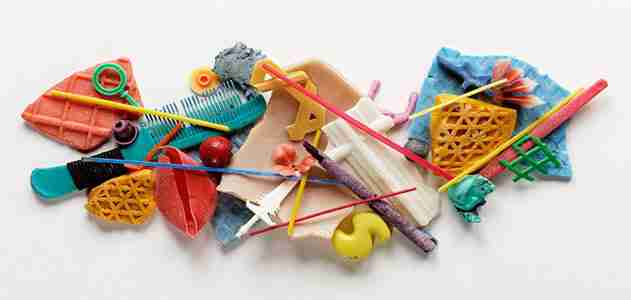
Judith Lang waves from a kelp pile on Kehoe Beach, shouting to her husband. “Here’s the Pick of the Day!”
The artist holds aloft her newfound treasure: the six-inch long, black plastic leg of an anonymous superhero toy. But did it come from Batman or Darth Vader? Only careful research will tell.
“We’ll google ‘black plastic doll leg,’” Richard Lang informs me, “and try to find out what it belonged to.”
In 1999, Richard and Judith had their first date on this Northern California beach. Both were already accomplished artists who had taught watercolor classes at the University of California and shown their work in San Francisco galleries. And both (unbeknown to each other) had been collecting beach plastic for years.
“This is a love story,” Richard says quietly. “Our passion is not only plastic but each other. We could never have imagined, on that day, what an incredible life would unfold—picking up other people’s garbage.”
It’s not just about picking up the plastic, but what he and Judith do with it. Since 1999, they’ve found countless ways to turn their huge collection of beach debris into extraordinary art. Partners and collaborators, they have created found-object works ranging from exquisite jewelry to mural-size photographs; from wall-mounted sculptures to, most recently, the coveted trophies awarded at the 2011 Telluride Mountainfilm Festival. Their work has appeared in exhibitions worldwide, from Singapore to San Francisco’s Museum of Modern Art.
“Our hope is to make these artworks so valuable,” Judith jokes, “that wars will be fought to clean up these beaches.”
* * *
A curving expanse of sand, kelp and driftwood patrolled by peregrine falcons, Kehoe rests on the edge of the Point Reyes National Seashore. It’s also on the edge of the North Pacific Gyre—a slow-moving ocean vortex that carries trash in an immense circuit around the sea.
The stormy season between December and April is the best time to search the beach for washed-up plastic. “It comes from cruise ship dumping, trash in the gutter, picnickers, tsunamis, hunters, farmers…” Richard says, shaking his head. “It reminds us that there is no away in ‘throwaway’ culture.”
Since 1999, the Langs have collected more than two tons of plastic. But it’s not your typical beach cleanup. “We’re not cleaning,” Richard points out. “We’re curating.”
During our two hours on Kehoe, we find plenty of common items: white Tiparillo tips, old Bic lighters, shriveled balloons, corroded SuperBalls, nylon rope and shotgun wads: the frayed plastic cores of shotgun shells, expelled when a shot is fired. The Langs scour the tide line and search below the rocky cliffs with Zen-like concentration. In the past, diligence has rewarded them with everything from vintage toy soldiers to tiny red Monopoly houses. But finding plastic on the beach, even if it’s your main art material, is always bittersweet. Vastly outnumbering those rare treasures are single-use water bottles, sun lotion tubes, soft-drink lids—and tiny round pellets called nurdles.
Nurdles, or “mermaid’s tears,” are by far the most common plastic found on Kehoe, in fact on any beach along the North Pacific Gyre. Smaller than popcorn kernels, these are the raw material from which plastic objects are made. Millions of nurdles escape during the manufacturing and transportation process, and often wash out to sea. The chemically receptive pellets readily absorb organic pollutants, and toxins like DDT and PCBs.
“They look like fish eggs,” observes Judith, holding one on her fingertip. “So birds eat them, and fish eat them. They’re little toxic time bombs, working their way up the food chain.”
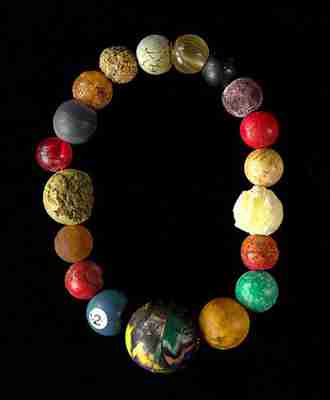
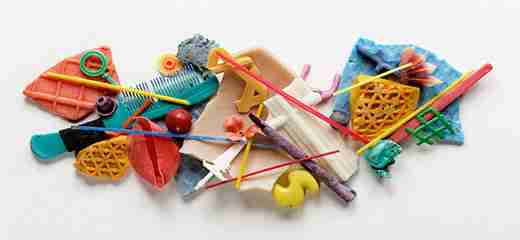
Richard approaches, his high spirits temporarily grounded. “We put a gloss on what we do and joke that it’s ‘garbage yoga’,” he says, “because there’s so much bending down and physical activity involved…”
“But it’s pretty sad,” continues Judith, finishing his thought. “To see this plastic strewn all over the beach. And it’s so recent. I remember going to the beach as a child; I never saw plastic. This problem has washed into our lives—and it’s not going to wash out any time soon.”
But creating beauty out of an ugly phenomenon—while raising awareness about the plague of plastic trash inundating the world’s oceans and beaches—is the Lang’s primary mission.
“When we make artwork out of this garbage, people are surprised,” says Judith. “They almost feel that it’s horrible these things are so beautiful.”
* * *
The Langs drive back home from Kehoe Beach with bulging duffle bags. The day’s harvest is rinsed off in a big bucket, laid out to dry and sorted by color, shape or purpose. Each piece of plastic they find has a secret story: a girl’s pink barrette; a kazoo; a tiny Pinocchio weathered almost beyond recognition.
Dozens of banker’s boxes are stacked in the artists’ studio (and in a rustic barn along the driveway of their home). Their sides are labeled by color or category: Red; Shoes; Yellow; Cutlery; Large Lids; Turquoise.
“And here’s a new category,” says Judith, holding up an unrecognizable chunk. “Plastic That Has Been Chewed On.”
The Langs often assemble sculptures from their beach plastic. Judith, working independently, fashions exquisite jewelry from some rather audacious objects. “I just sold a beautiful necklace made of white, pink and blue tampon applicators to Yale University,” she says merrily. “Along with a shotgun wad necklace. I’m hoping they’ll display the two together—and call it Shotgun Wedding .”
Most of their current work, though, involves large-scale photography of the beach plastic arranged in evocative groups. Their palette of objects is spread over a wide table covered with butcher’s paper. Surveying the objects, I spy paint can spray heads, doll arms, picture frames, a flamingo head, plastic fruit, rubber cement brushes, a toy horse, bits of plastic spaceships, dental floss picks, umbrella handles, cat toys, cheese spreaders, chunks of AstroTurf and squirt gun plugs.
“One of us will put a few pieces together,” Judith says, placing a few blue and green objects in a kind of arc. “That’s a beginning.”
“It kind of drifts around,” explains Richard, adding a pink hair curler. “Imagine the pieces as larval plankton, bumping against a newly formed volcanic rock.”
The artworks accrete slowly, like coral atolls. Arguments and epiphanies ensue. When the Langs are satisfied with their creation, they transport the objects to the Electric Works, Richard’s photography studio and art gallery in San Francisco’s Soma district. There, using a large-format digital camera, they capture their assemblage down to the finest detail.
Visually captivating and ecologically unsettling, the Langs’ pollutant-based artworks inspire a wry ambivalence. Beautiful as they are, I can’t help but wish they didn’t exist. But despite the “message” inherent in their work, Richard and Judith don’t treat it as a political statement.
“We’re artists first,” says Richard. “What we care about is creating beauty.”
By way of illustration, the Langs show me a striking photograph of luminescent domes glowing against a dark, textured background. After a moment, I recognize the dome-like objects: they’re highly magnified nurdles.
“We feel that beauty is a much better way to covey our message,” says Judith. “To be presented by these mysterious, glowing orbs creates intrigue. Then we can say, ‘We’re glad that you’re interested. Now let's talk about what this really is.’ ”
Trail Blazing
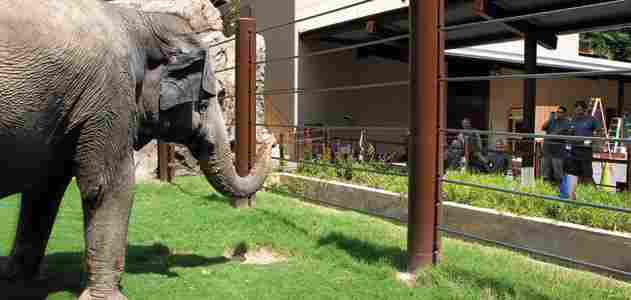
Annie Bissell is passionate about opera and elephants, but for now she is favoring elephants—as a volunteer at the Smithsonian’s National Zoo. She has given up her Washington National Opera subscription as well as wine tastings and three book groups so she can instead get up at 4 a three times a week to prepare meals for the elephants, shovel manure and help bathe them. “Working with these magnificent animals is a joyful commitment,” she says. Last fall, I joined Annie, Zoo director Dennis Kelly, diplomats, reporters, major donors, volunteers and staff to celebrate the opening of Phase 1 of Elephant Trails, the new home for Asian elephants. As I addressed the group, two elephants—34-year-old Shanthi and her 8-year-old son, Kandula—sauntered toward us. Kandula helped declare the facility a success when he waded into its new large recirculating pool and began taking his morning bath.
Elephant Trails includes spacious yards; an elephant barn designed to maximize both animal comfort and opportunities for scientific observation; a quarter-mile-long Elephant Exercise Trek; and an information center called the Homer and Martha Gudelsky Elephant Outpost. Here visitors can view a map showing 100 years of Asian elephant habitat reduction, interact with a simulated elephant tracking station and examine simulated elephant dung at a “poop station,” which is especially popular with kids; scientists use the real stuff to evaluate an elephant’s health.
By 2013, Elephant Trails will be complete and able to accommodate an entire matriarchal herd and individual bulls.
The facility also boasts several environmental innovations, including 30 geothermal wells drilled approximately 450 feet deep. These wells help keep temperatures and humidity in the new buildings at elephant-friendly levels. Cisterns capture and store rainwater for landscape irrigation. Low-maintenance native vegetation planted on the rooftops reduces storm water runoff, provides natural insulation and creates a bird and butterfly habitat.
Only 30,000 to 40,000 or so Asian elephants now exist in the wild in South and Southeast Asia; they are highly endangered. Smithsonian researchers were among the first to use satellite tracking technology to study elephants, and to gather data about elephant hormone levels and practice artificial insemination to breed them.
The Smithsonian is conducting a number of elephant research projects, some funded by Annie Bissell, who is also a major Zoo donor and recently joined the Friends of the National Zoo (FONZ) board. Other Zoo initiatives, such as a new genetics lab and a joint degree program with George Mason University, help us train conservation biologists—ensuring that our work with Asian elephants and other endangered species will continue, strong and growing into the future.
G. Wayne Clough is Secretary of the Smithsonian Institution.
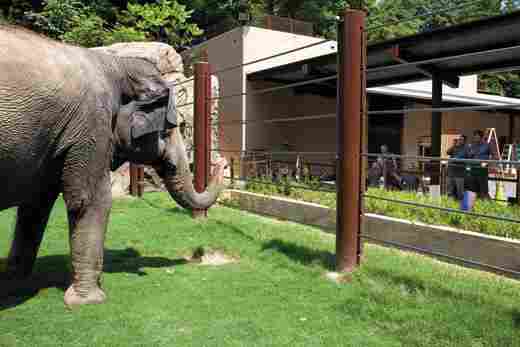
Tom Mirenda on Orchids
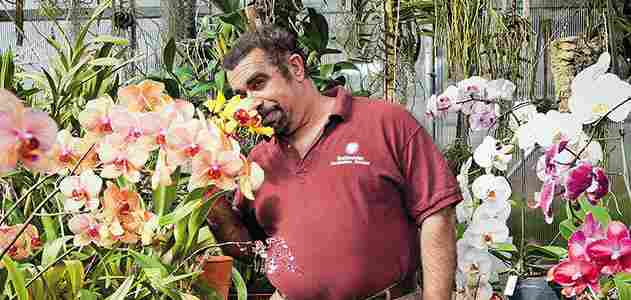
Tom Mirenda helps maintain the nearly 8,000 orchids in the Smithsonian’s collection, some of which are on display through April 24 in “Orchids: A View From the East” at the National Museum of Natural History. Mirenda spoke with the magazine’s Megan Gambino.
What is an orchid? It’s a botanical plant family. The first basic thing is that they all have three sepals and three petals. One of the petals is modified into what we call a lip, or labellum, which attracts a pollinator or facilitates pollination. Plus, the thing that really sets them apart is the reproductive structure in the center of the flower, which is called the column. It is the male and female parts of the flower fused together.
Are orchids the largest plant family? Well, that depends on who you talk to. Some botanists claim that the daisy family is the largest. But frankly, most daisies look alike. Orchids are infinitely diverse and probably have just as many species, if not more. People discover new orchids all the time, something like 300 or 400 new species every year.
Where do orchids live? All over the globe, except Antarctica, in every kind of habitat you can imagine, including deserts and swamps. There are orchids that live on beaches or limestone coral atolls and have adapted to salt spray. A few grow on the sides of streams, where they might be underwater for part of the year. They are extremely adaptable plants.
What is the wackiest orchid you’ve encountered? Some of the bulbophyllums smell particularly bad. They can drive you out of the greenhouse. Their stench has been compared to the scent of a thousand dead elephants rotting in the sun. One called coryanthes, or the bucket orchid, has a lip full of a viscous liquid. Bees fall in and start to drown, and the only way out is through an escape hatch in the back of the flower, where the pollen is. There is an orchid in Australia called the hammer orchid. When the pollinator lands on it, there is a cantilever effect and the lip bonks the pollinator on its back and deposits pollen. Orchids are really good at mimicking other things. Certain orchids have evolved to produce chemicals that are like pheromones, or sexual attractants. So insects go to the flowers and collect these chemicals to use like perfume. In other orchids, the lip looks almost exactly like a female insect, so inexperienced male insects will come to the flowers to try to mate with them.
The Smithsonian Orchid Collection began in 1974 with just five plants. How have you contributed to its growth? I am somewhat of an adventurous grower. I will often try things that maybe wouldn’t be thought about as being the best plants for this particular climate. I think I have diversified the collection quite a bit, getting some different genera that hadn’t been displayed in the Washington area and trying to get the collection to be more species-oriented than hybrid-oriented. That makes them more valuable as conservation subjects and more desirable as a teaching tool, to show people about all the weird and wonderful pollination syndromes that happen within orchids.
How many orchids from the collection are on exhibition? I’d say at any given time there will be 200 to 300 orchids within the exhibit. When you walk in, things are going to be displayed basically as they would have been in a Chinese scholar’s garden 500 years ago. Along the way, there will be discussions about the medicinal and cultural uses of orchids in Asia. Then, at the end of the show, we’ll be contrasting it with a big, splashy, Taiwan-style display, in which there will be hundreds of orchids more or less packed together to give you that wow factor.
Orchids are springing up more and more in grocery stores. What’s making them cheaper and more readily available? What you are seeing is the result of technology, particularly in Taiwan, which is one of the big powerhouses. The government subsidizes a lot of the orchid growers there and has built infrastructure to make sure that the farmers are successful in growing orchids. They have, literally, acres and acres and acres under glass there. Plus, it happens to be a really fine climate for growing orchids. They can export them in pot, in spike, in bloom, and they have worked out all of the really good ways of getting these plants pretty much anywhere in the world in perfect condition. Because they are doing it in such incredible quantities, they can land them, say in the U.S., for $4 or $5, which allows a wholesaler to turn around and sell them at Home Depot for $10 or $15. Even 10 or 20 years ago, for a decent orchid, you’d be paying $40 or $50. Something rare, 20, 40, 50 years ago, could cost you hundreds of dollars, if not thousands. But because now we mericlone them and we can produce, literally, hundreds of thousands of genetically identical plants, the cost is brought down considerably.
What kinds do you recommend for a home grower? Phalaenopsis are the best orchids for people to begin with. They are tolerant of low humidity and more or less like the same temperatures that people like. The trick to getting them to rebloom is to allow them to experience cool night temperatures, in the mid-50s, in the fall. The temperature dip causes the orchids to put out flower spikes. A lot of people don’t realize that. They keep their Phalaenopsis warm and wonder why the plants never bloom.
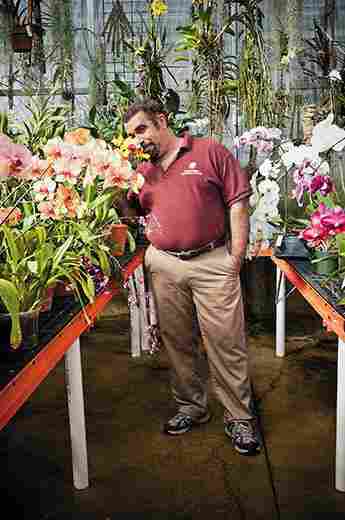

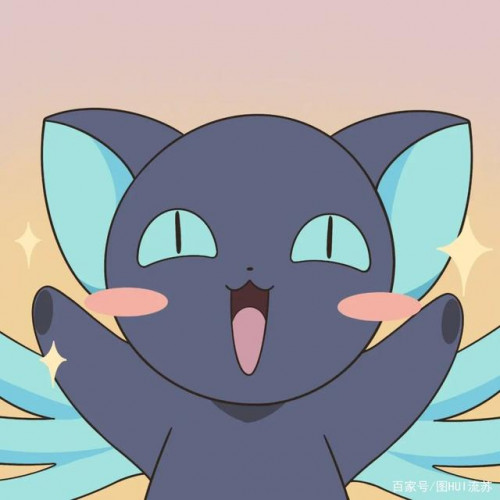

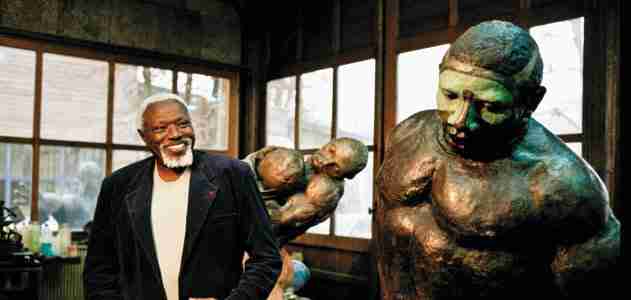
Post a Comment